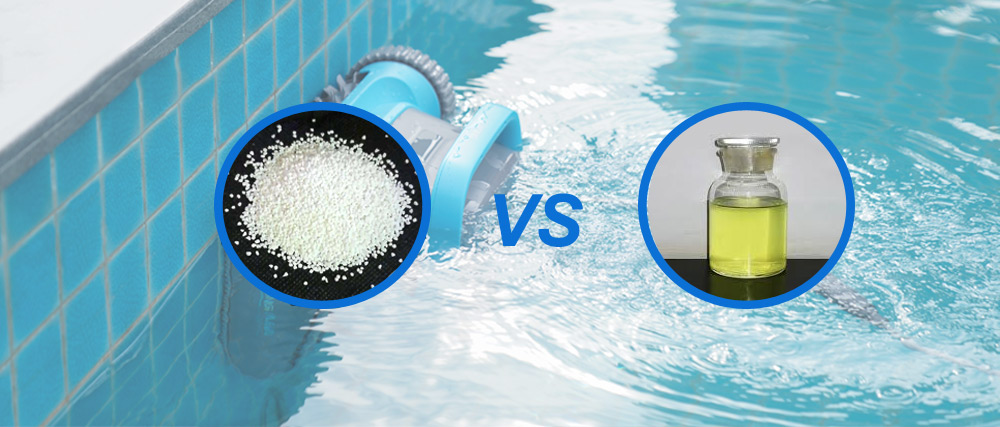
સ્વિમિંગ પૂલમાં,જંતુનાશક પદાર્થોમહત્વપૂર્ણ ભૂમિકા ભજવે છે. ક્લોરિન આધારિત રસાયણો સામાન્ય રીતે સ્વિમિંગ પુલમાં જીવાણુનાશક તરીકે ઉપયોગમાં લેવાય છે. સામાન્ય લોકોમાં સોડિયમ ડિક્લોરોસોસાયન્યુરેટ ગ્રાન્યુલ્સ, ટીસીસીએ ગોળીઓ, કેલ્શિયમ હાયપોક્લોરાઇટ ગ્રાન્યુલ્સ અથવા ગોળીઓ અને બ્લીચ (સોડિયમ હાયપોક્લોરાઇટ) શામેલ છે. તેમાંથી, એનએડીસીસી અને બ્લીચ (મુખ્ય ઘટક સોડિયમ હાયપોક્લોરાઇટ છે) એ બે સૌથી સામાન્ય જીવાણુનાશક છે. તેમ છતાં તે બંનેમાં ક્લોરિન છે, તેના ભૌતિક સ્વરૂપ, રાસાયણિક ગુણધર્મો અને સ્વિમિંગ પૂલના જીવાણુ નાશકક્રિયામાં એપ્લિકેશનમાં નોંધપાત્ર તફાવત છે.
સોડિયમ ડિક્લોરોઇસોસાયન્યુરેટ અને બ્લીચ વચ્ચેના ગુણધર્મોની તુલના
| લાક્ષણિકતાઓ | સોડિયમ ડિક્લોરોસોસાયન્યુરેટ (એસડીઆઈસી, એનએડીસીસી) | બ્લીચ (સોડિયમ હાયપોક્લોરાઇટ) |
| દેખાવ | સફેદ અથવા હળવા પીળા દાણા | રંગહીન અથવા હળવા પીળો પ્રવાહી |
| મુખ્ય ઘટકો | સોડિયમ ડિક્લોરોસોસાયન્યુરેટ (એસડીઆઈસી, એનએડીસીસી, ડિક્લોર) | સોડિયમ -હાયપોકરાઇટ |
| સ્થિરતા | ઘણા વર્ષોથી સામાન્ય પરિસ્થિતિમાં સ્થિર | ઘણા મહિનામાં તેની ઉપલબ્ધ ક્લોરિન સામગ્રીનો અસ્થિર, ઝડપી ડ્રોપ |
| અસરકારક કલોરિન | ઉચ્ચ, સામાન્ય રીતે 55-60% | નીચું, સામાન્ય રીતે 5%~ 12% |
| કાર્યક્ષમતા | ખૂબ સલામત, વાપરવા માટે સરળ | કાટમાળ, અનિશ્ચિત સામગ્રી |
| ભાવ | પ્રમાણમાં highંચું | સહેજ ઓછું |
સ્વિમિંગ પૂલ જીવાણુનાશમાં સોડિયમ ડિક્લોરોસોસાયન્યુરેટ અને બ્લીચનો ઉપયોગ
ફાયદાઓ:
ઉચ્ચ સલામતી: નક્કર ફોર્મ, લીક કરવું સરળ નથી, સંચાલન માટે પ્રમાણમાં સલામત છે.
સારી સ્થિરતા: લાંબા સ્ટોરેજ સમય, વિઘટન કરવું અને બિનઅસરકારક બનવું સરળ નથી.
સચોટ માપન: પાણીમાં ક્લોરિન સામગ્રીને નિયંત્રિત કરવા માટે પ્રમાણમાં ઉમેરવા માટે સરળ.
વિશાળ એપ્લિકેશન શ્રેણી: વિવિધ પ્રકારના સ્વિમિંગ પૂલમાં વાપરી શકાય છે.
ગેરફાયદા:
સ્વિમિંગ પૂલમાં રેડતા પહેલા ઓગળવાની જરૂર છે
બ્લીચની તુલનામાં, કિંમત વધારે છે.
બ્લીચ (સોડિયમ હાયપોક્લોરાઇટ)
ફાયદાઓ:
ઝડપી વિસર્જનની ગતિ: પાણીમાં ઝડપથી વિખેરવું સરળ અને ઝડપથી જીવાણુ નાશકક્રિયા અસરનો ઉપયોગ કરો.
ઓછી કિંમત: પ્રમાણમાં ઓછી કિંમત.
ગેરફાયદા:
ઉચ્ચ જોખમ: પ્રવાહી, ખૂબ કાટમાળ અને બળતરા, સાવચેતીથી નિયંત્રિત કરવાની જરૂર છે.
નબળી સ્થિરતા: વિઘટિત કરવા માટે સરળ, પર્યાવરણીય પરિબળો (તાપમાન, ભેજ, પ્રકાશ અને સંગ્રહ સમય) ને કારણે અસરકારક ક્લોરિન ઝડપથી ઘટાડો થાય છે. જ્યારે આઉટડોર પૂલમાં ઉપયોગ કરવામાં આવે છે, ત્યારે મફત ક્લોરિનની સ્થિરતા જાળવવા માટે સાયન્યુરિક એસિડ ઉમેરવાની જરૂર છે.
મીટરિંગમાં મુશ્કેલી: મીટરિંગ માટે વ્યાવસાયિક ઉપકરણો અને કર્મચારીઓ જરૂરી છે, અને ભૂલ મોટી છે.
સંગ્રહ અને પરિવહન આવશ્યકતાઓ વધારે છે.
નીચેની પરિસ્થિતિઓમાં સોડિયમ ડિક્લોરોઇસોસાયન્યુરેટનો શ્રેષ્ઠ ઉપયોગ થાય છે:
શોક ટ્રીટમેન્ટ: જો તમારા પૂલને આંચકો સારવારની જરૂર હોય, તો એસડીઆઈસી તમારી પ્રથમ પસંદગી છે. એસડીઆઈસી તેના કેન્દ્રિત પ્રકૃતિને કારણે આ માટે ખાસ કરીને અસરકારક છે. તમે ઘણાં બધાં ઉત્પાદન ઉમેર્યા વિના ક્લોરિનનું સ્તર ઝડપથી વધારી શકો છો, તેથી તમારા પૂલને જરૂરી ક્લોરિન સ્તર પ્રદાન કરવા માટે તે અસરકારક પસંદગી છે.
લક્ષિત એપ્લિકેશન: જો તમારા પૂલમાં શેવાળ વૃદ્ધિ અથવા વિશિષ્ટ સમસ્યાવાળા વિસ્તારો છે, તો એસડીઆઈસી લક્ષિત એપ્લિકેશન માટે પરવાનગી આપે છે. સીધા જ સમસ્યાના ક્ષેત્ર પર ગ્રાન્યુલ્સ છંટકાવ કરવો તે જરૂરી છે ત્યાં કેન્દ્રિત સારવાર પ્રદાન કરે છે.
નિયમિત જાળવણી: એસડીઆઈસી એ લોકો માટે વધુ યોગ્ય પસંદગી હોઈ શકે છે જેઓ વારંવાર તેમના પૂલને ક્લોરીનેટ કરે છે. ઉપયોગમાં સરળ અને સલામત એપ્લિકેશન બાળકો સાથેના પરિવારો અને પરિવારો માટે આદર્શ હોઈ શકે છે. તેની લાંબી શેલ્ફ લાઇફ સુનિશ્ચિત કરે છે કે જો તે લાંબા સમય સુધી સંગ્રહિત હોય તો પણ તે તેની અસરકારકતા જાળવી શકે. શ્રેષ્ઠ પૂલ એનએડીસીસી ઝડપથી ઓગળી જાય છે અને તરત જ કામ કરે છે!
સાવચેતીનાં પગલાં
સલામતી પ્રથમ: એનએડીસીસી અથવા બ્લીચનો ઉપયોગ કરીને, તમારે સલામત operating પરેટિંગ પ્રક્રિયાઓનું સખત પાલન કરવું જોઈએ અને રક્ષણાત્મક ઉપકરણો પહેરવા જોઈએ.
નિયમિત પરીક્ષણ: જીવાણુ નાશકક્રિયાની અસરને સુનિશ્ચિત કરવા માટે પાણીમાં અવશેષ ક્લોરિન સામગ્રીને નિયમિતપણે પરીક્ષણ કરો.
વ્યાપક વિચારણા: જંતુનાશક પદાર્થની પસંદગી કરતી વખતે, તમારે સ્વિમિંગ પૂલ, પાણીની ગુણવત્તા, બજેટ અને અન્ય પરિબળોના કદને ધ્યાનમાં લેવું જોઈએ.
એનએડીસીસી અને બ્લીચ બંને છેસામાન્યતરવું તેપૂલ જંતુનાશક પદાર્થો, દરેક તેના પોતાના ફાયદા અને ગેરફાયદા સાથે. યોગ્ય જીવાણુનાશક પસંદ કરવા માટે સ્વિમિંગ પૂલની વિશિષ્ટ શરતોના આધારે વ્યાપક વિચારણાની જરૂર છે. સામાન્ય રીતે કહીએ તો, એનએડીસીસી આઉટડોર ઓપન-એર પૂલ માટે અથવા જ્યારે આંચકો જરૂરી હોય ત્યારે વધુ યોગ્ય છે. ઉપયોગ, સંગ્રહ અને પરિવહનની સ્થિતિને તે જ સમયે ધ્યાનમાં લેતી વખતે, સ્વિમિંગ પૂલ રાસાયણિક સપ્લાયર્સ સોડિયમ ડિક્લોરોઇસોસાયન્યુરેટનો ઉપયોગ કરવાની ભલામણ કરે છે.
પોસ્ટ સમય: Oct ક્ટો -28-2024
